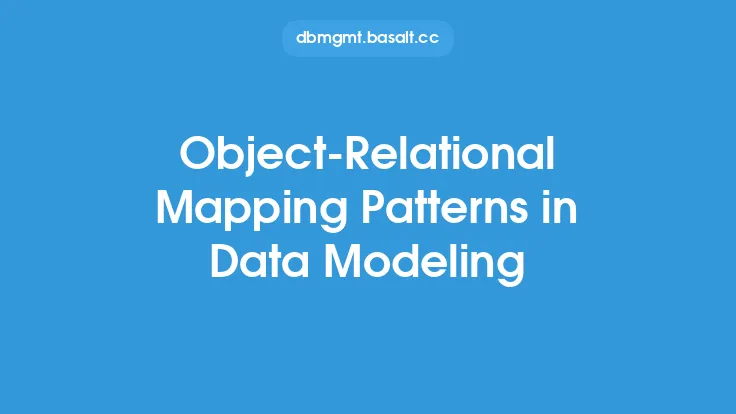Data integrity is a critical aspect of data modeling, as it ensures that the data stored in a database is accurate, consistent, and reliable. One of the key ways to achieve data integrity is by using data modeling patterns. These patterns provide a standardized approach to designing databases, which helps to prevent data inconsistencies and errors. In this article, we will explore some of the most effective data modeling patterns for improving data integrity.
Introduction to Data Modeling Patterns
Data modeling patterns are pre-defined templates or designs that can be used to create databases. They provide a structured approach to data modeling, which helps to ensure that the database is designed with data integrity in mind. Data modeling patterns can be used to design databases for a wide range of applications, from simple web applications to complex enterprise systems. By using data modeling patterns, developers can create databases that are scalable, flexible, and maintainable.
Entity Normalization
Entity normalization is a data modeling pattern that involves organizing data into entities, which are then normalized to ensure data integrity. Normalization involves dividing large entities into smaller, more manageable entities, each with its own set of attributes. This helps to eliminate data redundancy and improve data consistency. There are several levels of normalization, including first normal form (1NF), second normal form (2NF), and third normal form (3NF). Each level of normalization provides a higher level of data integrity, but also increases the complexity of the database design.
Data Validation Patterns
Data validation patterns are used to ensure that data entered into a database is accurate and consistent. These patterns involve defining rules and constraints that data must adhere to, such as data type, format, and range. Data validation patterns can be used to prevent errors, such as invalid data formats or out-of-range values, from being entered into the database. Common data validation patterns include check constraints, default values, and triggers.
Referential Integrity
Referential integrity is a data modeling pattern that ensures that relationships between entities are consistent and valid. This involves defining foreign keys, which are used to link entities together, and ensuring that the relationships between entities are valid. Referential integrity helps to prevent errors, such as orphaned records or invalid relationships, from occurring in the database. There are several types of referential integrity, including cascade delete, cascade update, and restrict.
Data Type Patterns
Data type patterns are used to define the format and structure of data in a database. These patterns involve selecting the most appropriate data type for each attribute, based on the type of data being stored. Common data types include integers, strings, dates, and timestamps. Data type patterns help to ensure that data is stored in a consistent and efficient manner, which improves data integrity and reduces errors.
Indexing Patterns
Indexing patterns are used to improve the performance of a database by providing a quick way to locate specific data. These patterns involve creating indexes on attributes that are frequently used in queries, such as primary keys or foreign keys. Indexing patterns help to improve data integrity by ensuring that data is retrieved quickly and efficiently, which reduces the risk of errors or inconsistencies.
Partitioning Patterns
Partitioning patterns are used to divide large databases into smaller, more manageable pieces. These patterns involve dividing data into partitions, based on a specific criteria, such as date or range. Partitioning patterns help to improve data integrity by reducing the risk of data corruption or loss, and improving the performance of the database.
Data Governance Patterns
Data governance patterns are used to ensure that data is managed and maintained in a consistent and controlled manner. These patterns involve defining policies and procedures for data management, such as data security, data backup, and data recovery. Data governance patterns help to improve data integrity by ensuring that data is handled and maintained in a way that is consistent with organizational policies and procedures.
Best Practices for Implementing Data Modeling Patterns
Implementing data modeling patterns requires a thorough understanding of the patterns and their application. Here are some best practices for implementing data modeling patterns:
- Start with a clear understanding of the business requirements and the data that needs to be stored.
- Use a standardized approach to data modeling, such as entity-relationship modeling or object-relational modeling.
- Use data modeling tools, such as entity-relationship diagrams or data modeling software, to design and implement the database.
- Test and validate the database design to ensure that it meets the business requirements and is free from errors.
- Use data modeling patterns, such as entity normalization and referential integrity, to ensure data integrity and consistency.
- Continuously monitor and maintain the database to ensure that it remains consistent and accurate over time.
Conclusion
Data modeling patterns are a critical aspect of data modeling, as they provide a standardized approach to designing databases that ensures data integrity and consistency. By using data modeling patterns, such as entity normalization, data validation patterns, and referential integrity, developers can create databases that are scalable, flexible, and maintainable. Additionally, by following best practices for implementing data modeling patterns, developers can ensure that their databases are designed and implemented in a way that meets the business requirements and is free from errors.





